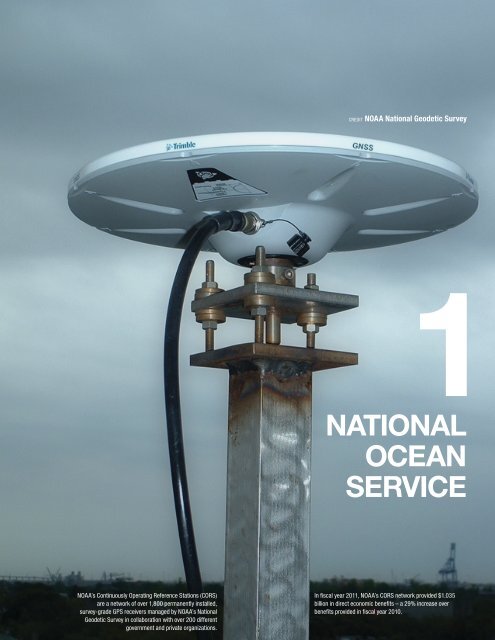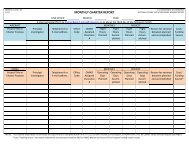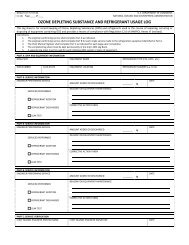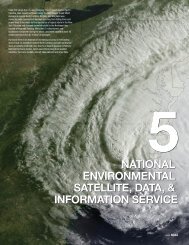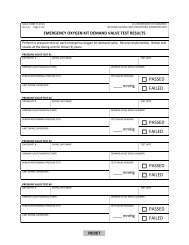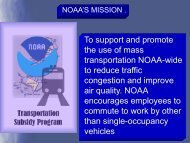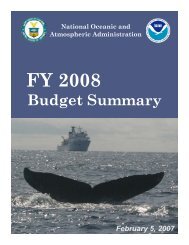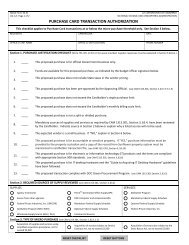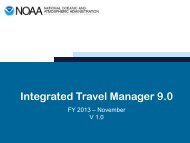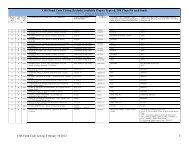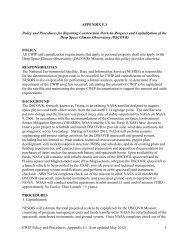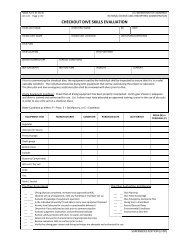Chapter 1 - NOAA
Chapter 1 - NOAA
Chapter 1 - NOAA
You also want an ePaper? Increase the reach of your titles
YUMPU automatically turns print PDFs into web optimized ePapers that Google loves.
CREDIT <strong>NOAA</strong> National Geodetic Survey<br />
NATIONAL<br />
OCEAN<br />
SERVICE<br />
<strong>NOAA</strong>’s Continuously Operating Reference Stations (CORS)<br />
are a network of over 1,800 permanently installed,<br />
survey-grade GPS receivers managed by <strong>NOAA</strong>’s National<br />
Geodetic Survey in collaboration with over 200 different<br />
government and private organizations.<br />
In fiscal year 2011, <strong>NOAA</strong>’s CORS network provided $1.035<br />
billion in direct economic benefits – a 29% increase over<br />
benefits provided in fiscal year 2010.
CHAPTER 1<br />
NATIONAL OCEAN SERVICE<br />
In the U.S., where over half of us live along the coast and more<br />
than 78 percent of our overseas trade by volume comes and goes<br />
through our seaports, the health of our coasts is intricately connected<br />
to the health of our Nation’s economy. 8 Through the National<br />
Ocean Service (NOS), <strong>NOAA</strong> is the lead Federal agency providing<br />
science-based solutions to address evolving economic, environmental,<br />
and social pressures on our oceans and coasts. NOS observes,<br />
measures, assesses, and manages the Nation’s coastal, ocean<br />
and Great Lakes areas, provides critical navigation products and<br />
services, and conducts response and restoration activities to protect<br />
vital coastal resources. Federal agencies, states, local governments,<br />
Debris from the tsunami that devastated Japan in March<br />
2011 could reach the United States as early as this<br />
winter, according to predictions by <strong>NOAA</strong> scientists.<br />
NATIONAL OCEAN SERVICE<br />
non-profits, and the private sector utilize NOS products and services to<br />
make informed policy, management, and business decisions, which have<br />
strong implications for economic activity and the health of ecosystems<br />
along the Nation’s coasts.<br />
NOS also works with other <strong>NOAA</strong> Line Offices to achieve broader <strong>NOAA</strong><br />
goals. For example, NOS contributes to the National Weather Service<br />
tsunami warning forecasts by providing real-time tidal data from the National<br />
Water Level Observation Network. This data is a critical component of the<br />
U.S. National Tsunami Warning System and enables accurate warnings,<br />
effective models of tsunami arrival times, and timely evacuation orders. In<br />
addition, NOS works with the National Marine Fisheries Service and <strong>NOAA</strong>’s<br />
General Counsel for Natural Resources to form <strong>NOAA</strong>’s Damage Assessment,<br />
Remediation, and Restoration Program (DARRP). DARRP collaborates<br />
with other agencies, industry, and citizens to protect coastal and<br />
marine resources, respond to pollution incidents, assess risk and injuries,<br />
and restore damaged resources.<br />
Healthy and resilient coastal communities are essential to the Nation’s economy,<br />
providing the Nation with goods through our ports, food to support<br />
local communities and industry, and recreational opportunities for Americans<br />
and international travelers alike. Yet these communities are vulnerable<br />
to sea-level rise, severe storms, habitat loss and frequent disasters. Against<br />
these challenges, NOS fosters vibrant coastal economies by enabling safe<br />
and efficient marine transportation, restoring coastal habitat, protecting<br />
unique marine resources, and delivering data and products from real-time<br />
8<br />
2003 Pocket Guide to Transportation Table 5-5, U.S. Department of Transportation<br />
1-13
NATIONAL OCEANIC AND ATMOSPHERIC ADMINISTRATION<br />
FY 2013 BUDGET SUMMARY<br />
ocean and coastal observations to meet resource managers’ needs. For example, The <strong>NOAA</strong> Physical<br />
Oceanographic Real Time System (PORTS®) is a decision support tool that improves the safety and<br />
efficiency of maritime commerce and coastal resource management through the integration of real-time<br />
environmental observations, forecasts and other geospatial information. PORTS® provides observations<br />
and predictions of water levels, currents, salinity, and meteorological parameters (e.g., winds, atmospheric<br />
pressure, air and water temperatures) that mariners need to navigate safely.<br />
NOS also conducts and oversees essential applied research on topics such as harmful algal blooms and<br />
hypoxia. This research leads to improved forecasting, helping resource managers ensure the safety of<br />
coastal resource users during these types of events. In addition, NOS activities inform science-based<br />
ocean and coastal resource management, as well as ecosystem-based management, an approach which<br />
NOS has successfully demonstrated through the National Marine Sanctuaries Program.<br />
NOS programs also help <strong>NOAA</strong> achieve its Next Generation Strategic Plan long-term goal of ensuring<br />
resilient coastal communities and economies through comprehensive planning and management to address<br />
competing ocean and coastal uses, provision of geospatial services to support coastal communities,<br />
and the availability of the best natural and social science for coastal decision makers.<br />
FY 2011 ACCOMPLISHMENTS<br />
<strong>NOAA</strong>, the Department of Interior, and five states – the members of the Trustee Council-<br />
reached an unprecedented agreement with BP in 2011 to provide $1 billion for early<br />
restoration projects in the Gulf of Mexico, as down payment on compensation for the<br />
2010 Deepwater Horizon oil spill. This early restoration agreement, the largest of its kind<br />
ever reached, represents a first step toward fulfilling BP’s obligation to restore injured<br />
public resources, including the loss of use of those resources by affected people. The<br />
Trustees will use the money to fund projects such as the rebuilding of coastal marshes,<br />
replenishment of damaged beaches, conservation of sensitive areas for ocean habitat<br />
for injured wildlife, and restoration of barrier islands and wetlands that provide natural<br />
protection from storms. This money provides an opportunity to help restoration get<br />
started sooner. The selection of early restoration projects includes a public process, and<br />
is overseen by the Trustees.<br />
In January 2011, Carnival Cruise Lines expressed concerns about reduced clearance<br />
on the Dames Point Bridge in Jacksonville, Florida. They were prepared to divert their<br />
ships and the $3.4 million in critical tourism revenue they generate for the Jacksonville<br />
economy. In response to a request from the Florida Department of Transportation,<br />
<strong>NOAA</strong> installed an air gap measuring system on the Dames Point Bridge. The air gap<br />
system is a tool that measures the clearance between the water surface and a bridge,<br />
enabling large vessels, such as cruise liners and commercial shipping vessels, to pass<br />
safely under the bridge. With the addition of this system, Carnival Cruise Lines kept<br />
their vessels on their original routes to Jacksonville. This is an example of how NOS<br />
products and services benefit local communities and industries, and help to sustain and<br />
grow strong economies.<br />
Coastal marshes, like these in Louisiana, will be<br />
restored with early restoration funding<br />
An employee from the Center for Operational<br />
Oceanographic Products and Services installs an<br />
air gap sensor which measures bridge clearance<br />
on the Verrazano-Narrows Bridge, New York.<br />
The sensor is part of the New York/New Jersey<br />
Physical Oceanographic Real-Time System.<br />
Information from the sensor is critical for underbridge<br />
clearance, as ships continue to maximize<br />
channel depths and widths while, at the same<br />
time, push the bounds of bridge heights<br />
1-14
CHAPTER 1<br />
NATIONAL OCEAN SERVICE<br />
FY 2013 REQUEST $478,066,000<br />
<strong>NOAA</strong> requests a total of $478,066,000 and 1,224 FTEs to support the continued and enhanced operations<br />
of the National Ocean Service. This total includes Operations, Research, and Facilities (ORF) and<br />
other Mandatory and Discretionary accounts. For the Discretionary accounts this includes a decrease of<br />
$8,906,000 and 18 FTEs from the FY 2012 estimate. This reduction is comprised of a net decrease of<br />
$7,697,000 and 14 FTEs in program changes plus a decrease of $1,209,000 and 4 FTEs for Adjustments<br />
to Base (ATB).<br />
In FY 2013, NOS will support the highest priority and most essential services for coastal communities<br />
and the Nation. NOS will continue to create solutions to improve coastal management by providing<br />
science-based services and strengthening place-based initiatives to reduce the vulnerability of coastal<br />
communities to risks such as storm surge and sea level rise. NOS will continue to improve alignment of<br />
coastal habitat-related efforts to achieve long-term habitat protection and coastal resiliency. In addition,<br />
NOS will use its social science expertise and partnerships to enhance the effectiveness of NOS products<br />
and services.<br />
1-15
NATIONAL OCEANIC AND ATMOSPHERIC ADMINISTRATION<br />
FY 2013 BUDGET SUMMARY<br />
NATIONAL OCEAN SERVICE<br />
(DOLLARS IN THOUSANDS)<br />
FY 2011<br />
SPEND PLAN<br />
FY 2012<br />
ESTIMATE<br />
FY 2013<br />
REQUEST<br />
INCREASE<br />
(DECREASE)<br />
NOS — ORF<br />
Navigation Services $154,200 $147,958 $149,589 $1,631<br />
Ocean Resources Conservation & Assessment 168,941 163,260 166,077 2,817<br />
Ocean and Coastal Management 152,335 148,154 142,800 (5,354)<br />
Total, NOS - ORF 475,476 459,372 458,466 (906)<br />
Total, NOS - PAC 19,366 8,000 0 (8,000)<br />
Total, NOS - Other 55,326 22,600 19,600 (3,000)<br />
GRAND TOTAL NOS (Direct Obligations) $550,168 $489,972 $478,066 ($11,906)<br />
Total FTE 1,274 1,242 1,224 (18)<br />
$800,000<br />
$700,000<br />
$600,000<br />
$500,000<br />
(Dollars in thousands)<br />
NATIONAL OCEAN SERVICE<br />
Budget Trends FY 2007-2013<br />
$400,000<br />
$300,000<br />
$200,000<br />
$100,000<br />
Other<br />
PAC<br />
ORF<br />
$0<br />
2007<br />
Enacted<br />
2008<br />
Enacted<br />
2009<br />
Enacted<br />
2010<br />
Enacted<br />
2011<br />
Spend Plan<br />
2012<br />
Estimate<br />
2013<br />
Request<br />
ORF: Operations, Research, and Facilities<br />
PAC: Procurement, Acquisition, & Construction<br />
Other: Sanctuaries Enforcement Asset Forfeiture Fund; Coastal Impact Assistance Fund; Coastal Zone Management Fund; Damage Assessment and<br />
Restoration Revolving Fund<br />
1-16
CHAPTER 1<br />
NATIONAL OCEAN SERVICE<br />
A navigation response team deployed to Maine’s<br />
dangerous Cobscook Bay in 2010. The Eastport fishing<br />
community asked for full bottom surveys and updates<br />
to nautical charts after several men lost their lives when<br />
their boats capsized.<br />
FY 2013 ORF BUDGET SUMMARY<br />
<strong>NOAA</strong> requests a total of $458,466,000 and 1,208 FTEs to support the Operations, Facilities, and<br />
Research (ORF) of the National Ocean Service. This is a decrease of $906,000 and 17 FTEs from the<br />
FY 2012 level. This reduction includes an increase of $303,000 and a decrease of 13 FTEs in program<br />
changes plus a decrease of $1,209,000 and 4 FTEs for ATBs. Adjustments include the following transfers:<br />
• <strong>NOAA</strong> requests a technical adjustment to move $498,000 and 1 FTE from NOS Estuary<br />
Restoration Program to NFMS Habitat Management & Restoration. This transfer will shift the<br />
responsibilities of the <strong>NOAA</strong>’s Estuary Restoration Program to the Office of Habitat Conservation<br />
• <strong>NOAA</strong> requests a technical adjustment to move $4,618,000 and 3 FTE from NOS Marine Debris<br />
to NMFS Habitat Management & Restoration. This transfer will shift the responsibilities of <strong>NOAA</strong>’s<br />
Marine Debris Program to the Office of Habitat Conservation.<br />
NOS — ORF PROGRAM CHANGE HIGHLIGHTS FOR FY 2013:<br />
Select program changes (generally above $500,000) are highlighted below at the sub-activity level. A<br />
summary of funding by Program, Project and Activity (PPA) is located in <strong>Chapter</strong> 9, Appendices. Detailed<br />
descriptions of all program changes by PPA are located in the <strong>NOAA</strong> FY 2013 Congressional Justification.<br />
NAVIGATION SERVICES $149,589,000<br />
<strong>NOAA</strong> requests a decrease of $130,000 and 17 FTEs for a total of $149,589,000 and 533 FTEs under the<br />
Navigation Services sub-activity.<br />
Mapping and Charting: <strong>NOAA</strong> requests a decrease of $1,448,000 and 17 FTEs. This is comprised of<br />
one increase and two decreases:<br />
Mapping and Charting Base, Eliminate Navigation Response Teams: <strong>NOAA</strong><br />
requests a decrease of $2,300,000 and 17 FTEs to terminate the Navigation<br />
Response Team (NRT) program in FY 2013. NRTs currently provide 24/7<br />
emergency hydrographic survey support to the U.S. Coast Guard, port officials,<br />
and other first responders in the wake of accidents and natural events that create<br />
navigation hazards which impede safe and efficient marine transportation and commerce.<br />
However, there are more cost-effective ways to support this activity. Beginning<br />
in FY 2013, <strong>NOAA</strong> will pursue an agreement to provide technical assistance to<br />
the Federal Emergency Management Agency, which has the authority to fund the<br />
assessment of navigational hazards associated with Presidentially-declared disasters.<br />
Mapping and Charting Base, Support Mapping and Charting Activities: <strong>NOAA</strong><br />
requests an increase of $1,060,000 and 0 FTEs to improve the accuracy<br />
of nautical charts for safe navigation. Mapping and charting activities ensure<br />
safe navigation, maintain hydrographic expertise, and support coastal management.<br />
The information provided through <strong>NOAA</strong>’s nautical charts is an essential contribution to<br />
jobs and the economy by supporting a safe, efficient and environmentally sound marine<br />
1-17
NATIONAL OCEANIC AND ATMOSPHERIC ADMINISTRATION<br />
FY 2013 BUDGET SUMMARY<br />
transportation system. This increase to the Mapping and Charting program provides the<br />
expertise needed for verification and validation of survey data. Specifically, survey data<br />
collected from <strong>NOAA</strong> and contractors will be applied to nautical charts and made accessible<br />
for non-navigations uses.<br />
Hydrographic Research & Technology Development: <strong>NOAA</strong> requests a decrease<br />
of $318,000 and 0 FTE to reduce grant funding at the Joint Hydrographic Center.<br />
<strong>NOAA</strong>’s Joint Hydrographic Center (JHC) evaluates sonar technologies and processes<br />
to improve efficiencies in hydrographic data acquisition. At this funding level, <strong>NOAA</strong> will<br />
reduce the amount of grant funding provided to <strong>NOAA</strong>’s Joint Hydrographic Center that<br />
supports research personnel. The program will continue to develop improved standards<br />
and methods for collecting data and creating Integrated Ocean and Coastal Mapping<br />
(IOCM) products such as habitat maps from nautical charting data, or nautical charting<br />
data from fish survey assessments on an adjusted timetable. <strong>NOAA</strong> will procure new<br />
technologies for hydrographic testing and development as resources allow.<br />
Tides and Currents: <strong>NOAA</strong> requests an increase of $1,226,000 and 0 FTEs. This is comprised of one<br />
increase:<br />
Tide and Current Data Base, Enhance the Tide and Current Data Program:<br />
<strong>NOAA</strong> requests an increase of $1,226,000 and 0 FTEs to ensure that timely,<br />
accurate and reliable oceanographic data and products are available when<br />
most needed. Tide and Current data is essential for navigation safety, oil spill response,<br />
National Weather Service storm surge and tsunami warnings, and long-term<br />
sea level change planning. Ensuring the availability of timely, accurate and reliable<br />
data helps ensure that these services are efficient and provide the most value to<br />
the American people. This increase will enable <strong>NOAA</strong> to inspect an additional 60<br />
National Water Level Observation Network (NWLON) stations per year to adequately<br />
maintain and operate the full multi-mission functions of the network. <strong>NOAA</strong> will also<br />
collect data on coastal currents at an additional 30 locations per year, for a total of<br />
70, which will help to improve tidal current predictions for mariners and watermen,<br />
for search and rescue operations, and enhance the response efforts for oil spills and<br />
other hazards.<br />
OCEAN RESOURCES CONSERVATION AND ASSESSMENT $166,077,000<br />
<strong>NOAA</strong> requests an increase of $6,543,000 and 4 FTEs for a total of $166,077,000 and<br />
426 FTEs under the Ocean Resources Conservation and Assessment sub-activity.<br />
The Center for Operational Oceanographic Products<br />
and Services (COOPS) conducts surveys of tidal<br />
currents in response to user requests. Here, scientists<br />
deploy current meter buoys and anchors used for the<br />
surveys.<br />
Ocean Assessment Program: <strong>NOAA</strong> requests an increase of $2,383,000 and 0<br />
FTEs. This is comprised of three increases, two decreases and two terminations:<br />
IOOS Regional Observations, Develop Improved Marine Sensors: NOS requests<br />
an increase of $6,564,000 and 0 FTEs for IOOS Regional Observations to develop<br />
and improve marine sensors that will monitor changing conditions in the oceans,<br />
coasts, and Great Lakes. With this increase <strong>NOAA</strong> will establish a $10,000,000 marine<br />
sensor program by reallocating $3,436,000 within the funds available to the regional<br />
associations and other grant recipientsto participate in this effort. Approximately 100<br />
1-18
CHAPTER 1<br />
NATIONAL OCEAN SERVICE<br />
Scientists from the Office of Coast Survey and the<br />
University of New Hampshire lower a sophisticated echo<br />
sounder into the water to create a three-dimensional<br />
map of the sea floor. The data collected will help<br />
scientists better understand the underwater landscape<br />
and improve climate and ocean current circulation<br />
models.<br />
million Americans use coastal and Great Lakes waters for recreation each year, many<br />
of them multiple times, and they are exposed to an increasingly dangerous array of<br />
ocean health threats. Through this increase, <strong>NOAA</strong> will make competitive awards for<br />
the development, demonstration, testing, and evaluation of marine sensor technologies<br />
that will help to deliver rapid and cost-effective data to inform our understanding<br />
of coastal, ocean, and Great Lakes ecosystems, supporting better decision-making<br />
to improve public, animal, and ecosystem health and their connections to a strong<br />
economy. To ensure the most efficient use of limited resources, demonstrations will<br />
focus on topics with potential to result in significant improvements to meet National<br />
Ocean Policy priorities related to: 1) informing decisions and improving understanding,<br />
2) water quality, and 3) observations, mapping, and infrastructure.<br />
Coastal Services Center, Reduce Number of New Coastal Services Center<br />
Products: <strong>NOAA</strong> requests a decrease of $1,433,000 and 0 FTEs for the<br />
Coastal Services Center (CSC). CSC provides the technology, information, and<br />
management strategies used by local, state, and national organizations to address<br />
complex coastal issues. This reduction will result in the development of fewer new or<br />
enhanced climate products by CSC. However, <strong>NOAA</strong> will seek to leverage external<br />
resources and capabilities through its ongoing partnerships with states and other Federal<br />
agencies to ensure that coastal communities continue to be aware of and are able to<br />
access the broader range of Federal (and non-Federal) services that CSC helps support.<br />
CSC will continue to support its regionally-targeted activities in FY 2013 (i.e., Pacific, Gulf,<br />
and West) as well as the Coastal Storms Program.<br />
Coastal Services Center, Eliminate Regional Geospatial Modeling Grants: <strong>NOAA</strong><br />
requests a decrease of $2,861,000 and 0 FTEs for the Regional Geospatial Modeling<br />
grant program. <strong>NOAA</strong> does not propose to continue this Congressionally-directed<br />
program in FY 2013. Base funding from CSC and the National Geodetic Survey already<br />
supports a range of geospatial requirements including capacity building and the development<br />
of tools and models.<br />
Response and Restoration: <strong>NOAA</strong> requests an increase of $2,536,000 and 4 FTEs. This is comprised<br />
of two increases:<br />
Gulf of Mexico Restoration Effort: Edward Wisner<br />
Donation Marsh Restoration.<br />
Response and Restoration Base, Enhance <strong>NOAA</strong>’s Natural Resource Damage<br />
Assessment Capacity: <strong>NOAA</strong> requests an increase of $2,000,000 and 4 FTEs<br />
to improve <strong>NOAA</strong>’s capacity to conduct Natural Resource Damage Assessment<br />
(NRDA) and to expedite the restoration process. As a natural resource<br />
trustee, <strong>NOAA</strong> is charged with conducting a NRDA in collaboration with affected<br />
tribal, state and Federal co-trustees to assess and restore natural resources injured<br />
by an oil spill or other hazardous chemical release (as well as ship groundings).<br />
<strong>NOAA</strong> frequently must use base funds to conduct damage assessments following<br />
oil and chemical spills, perform legal work toward settlements, and to carry out<br />
restoration planning. <strong>NOAA</strong> will use this increased funding to hire additional staff<br />
to advance the more than 200 cases (in addition to Deepwater Horizon) for which<br />
1-19
NATIONAL OCEANIC AND ATMOSPHERIC ADMINISTRATION<br />
FY 2013 BUDGET SUMMARY<br />
<strong>NOAA</strong> is currently engaged in as a trustee. Some of these cases represent hundreds of<br />
millions of dollars in potential settlements—a substantial investment in habitat restoration<br />
across the Nation. Expediting the backlog of NRDA cases will lead to swifter recourse for<br />
the public when public trust resources are harmed as a result of pollution events.<br />
Response and Restoration Base, Enhance <strong>NOAA</strong>’s Response and Restoration<br />
Capacity: <strong>NOAA</strong> requests an increase of $536,000 and 0 FTEs to improve <strong>NOAA</strong>’s<br />
capacity to prepare for and respond to coastal environmental hazards. <strong>NOAA</strong>’s<br />
Office of Response and Restoration (OR&R) protects coastal and marine resources,<br />
mitigates threats, reduces harm, and restores ecological function. This increase will<br />
provide for: 1) greater <strong>NOAA</strong> engagement in and support for spill response preparedness<br />
in the Arctic, including review of plans and participation in Arctic drills and exercises, 2)<br />
the activation of ERMA modules in a robust cloud server environment to ensure reliable<br />
access to ERMA services critical to helping decision makers mitigate and remediate the<br />
environmental and economic impacts of oil spills, chemical releases and ship groundings,<br />
and 3) development of a comprehensive toolkit of response tools and training programs.<br />
National Centers for Coastal Ocean Science (NCCOS): <strong>NOAA</strong> requests an increase of $1,624,000 and<br />
0 FTEs. This is comprised of one decrease and one increase:<br />
National Centers for Coastal Ocean Science: <strong>NOAA</strong> requests a decrease of<br />
$344,000 and 0 FTEs to reflect savings from a realignment of NCCOS intramural<br />
research activities. In FY 2010 and 2011, NCCOS has been engaged in an ongoing<br />
evaluation and transformation of its intramural research portfolio. This has resulted in<br />
consolidating scientific priorities into four thematic areas consistent with Congressional<br />
direction, Administration and Agency priorities, and in line with NCCOS capabilities. In<br />
FY 2013, NCCOS will transition out of the laboratories in Oxford, MD and Kasitsna Bay,<br />
AK. Additionally, administrative functions have been streamlined and consolidated to<br />
increase the efficiency of operations. Achieving administrative efficiencies has resulted in<br />
a reduced number of contract positions at the Center for Coastal Ecosystem Health and<br />
Biomolecular Research in Charleston, SC and at NCCOS Headquarters in Silver Spring,<br />
MD.<br />
Competitive Research, National Centers for Coastal and Ocean Science<br />
Competitive Research: <strong>NOAA</strong> requests an increase of $1,968,000 and 0<br />
FTEs for NCCOS’s Competitive Research program. NCCOS’s Competitive<br />
Research program supports competitive, peer reviewed interdisciplinary research<br />
investigations with finite life cycles focused on priority coastal ecosystem issues.<br />
Research projects are selected through national competitions to ensure that they<br />
are not only of the highest scientific integrity but that they provide actionable<br />
information that can be used by coastal managers such as long- and short-term<br />
ecological forecasts. With this increase, <strong>NOAA</strong> will continue to focus on the highest<br />
priority research projects including harmful algal blooms, hypoxia, and coastal<br />
ecosystem research.<br />
This deep red harmful algae, called Lingulodinium<br />
polyedrum, often produces brightly colored water<br />
discoloration. It has been associated with fish and<br />
shellfish mortality events, but its threat to human health<br />
is still being evaluated. (photo credit: Kai Schumann,<br />
California Department of Public Health volunteer)<br />
1-20
CHAPTER 1<br />
NATIONAL OCEAN SERVICE<br />
OCEAN AND COASTAL MANAGEMENT $142,800,000<br />
<strong>NOAA</strong> requests a decrease of $6,110,000 and 0 FTEs for a total of $142,800,000 and 249 FTEs under the<br />
Ocean and Coastal Management sub-activity.<br />
Coastal Management: <strong>NOAA</strong> requests a decrease of $3,067,000 and 0 FTEs. This is comprised of two<br />
decreases and two increases:<br />
CZ and Stewardship, Coastal Zone Management Programs and Coastal Services:<br />
<strong>NOAA</strong> requests a decrease of $1,055,000 and 0 FTEs for the consolidation of<br />
<strong>NOAA</strong>’s coastal programs. <strong>NOAA</strong> must ensure that government resources are utilized<br />
as efficiently as possible and focused on current and emerging coastal management<br />
challenges. An internal review of <strong>NOAA</strong>’s coastal activities is being undertaken to provide<br />
a more streamlined and focused coastal program. The proposed savings will be realized<br />
by merging the administration of multiple coastal programs.<br />
Cover image of the Governors’ Action Plan II<br />
Building on successes of the first Action Plan,<br />
the Gulf States and their partners developed the<br />
Governors’ Action Plan II, a farther-reaching,<br />
five-year regional plan that looks to expand<br />
partnerships. Photo credit: Gulf of Mexico<br />
Alliance Governors’ Action Plan<br />
Regional Ocean Partnership Grants, Expand Regional Ocean Partnership Grants:<br />
<strong>NOAA</strong> requests an increase of $511,000 and 0 FTEs to expand a targeted competitive<br />
grant program to advance regional ocean management through support<br />
for regional ocean partnerships (ROPs). ROPs support the effective management<br />
of ocean and coastal resources that contribute $230 billion each year to the national<br />
economy in market based outputs, in addition to the effective management of ecological<br />
systems that increase property values and the quality of life in coastal areas. Working<br />
through regional public processes, these governor-led partnerships have identified critical<br />
coastal and ocean management issues facing multiple states in a region, such as: coastal<br />
water quality, nutrient loading and clean beaches, and habitat restoration, protection<br />
and characterization. A comprehensive regional approach to science-based, placebased<br />
planning for multiple uses of ocean and coastal resources yields many tangible<br />
benefits. This increase will enable the grant program to continue to support key priority<br />
actions identified in the plans of existing regional ocean partnerships (Gulf of Mexico<br />
Alliance, Northeast Regional Ocean Council, Mid-Atlantic Regional Council on the Ocean,<br />
the South Atlantic Alliance, and the West Coast Governors Alliance on Ocean Health), as<br />
well as the development and implementation of place-based ocean management plans in<br />
other regions (e.g. the Pacific and Caribbean territories, and Alaska).<br />
National Estuarine Research Reserve System (NERRS), NERRS Program: <strong>NOAA</strong><br />
requests a decrease of $2,733,000 and 0 FTEs for the NERRS program. NERRS<br />
is a national network protecting more than 1.3 million coastal and estuarine acres in<br />
28 reserves located in 22 states and Puerto Rico for purposes of long-term research,<br />
environmental monitoring, education and stewardship. At this funding level, <strong>NOAA</strong> will<br />
eliminate the NERRS graduate fellowship program and decrease funding to each of the<br />
28 reserves across the U.S. However, NERRS will continue their commitment to their<br />
core mission by working with local communities and regional groups to address natural<br />
resource management issues, such as non-point source pollution, habitat restoration, and<br />
invasive species.<br />
1-21
NATIONAL OCEANIC AND ATMOSPHERIC ADMINISTRATION<br />
FY 2013 BUDGET SUMMARY<br />
Ocean Management: <strong>NOAA</strong> requests a decrease of $3,043,000 and 0 FTEs. This is comprised of one<br />
decrease and one reduction:<br />
<strong>NOAA</strong> requests a decrease of $3,043,000 and 0 FTEs within the Marine Sanctuaries<br />
Program. The FY 2013 President’s Budget proposes to consolidate the National<br />
Marine Protected Areas Center with the Office of National Marine Sanctuaries to create<br />
a single more efficient and effective program. This request will continue support for<br />
the 13 Sanctuaries in the National Marine Sanctuary System, the Papahānaumokuākea<br />
Marine National Monument, and National Marine Protected Areas Center as required by<br />
Executive Order 13158. The proposed consolidation will allow <strong>NOAA</strong> to fully leverage<br />
ONMS capacities and regional networks for management MPAs and foster more effective<br />
information sharing among national and regional ocean management interests. At the requested<br />
funding level <strong>NOAA</strong> will support the highest priorities of all its mandates, maintain<br />
its unique capabilities, and continue engaging coastal communities and stakeholders to<br />
promote science-based stewardship of designated areas.<br />
FY 2013 PAC BUDGET SUMMARY<br />
<strong>NOAA</strong> requests a total of $0 and 0 FTEs to support the Procurement, Acquisition and Construction (PAC)<br />
of the National Ocean Service. This is a decrease of $8,000,000 and 1 FTE from the FY 2012 level. This<br />
reduction includes a decrease of $8,000,000 in program changes and a decrease of 1 FTE plus $0 and 0<br />
FTEs for Adjustments to Base (ATB).<br />
NOS — PAC PROGRAM CHANGE HIGHLIGHTS FOR FY 2013:<br />
Select program changes (generally above $500,000) are highlighted below at the sub-activity level. A<br />
summary of funding by Program, Project and Activity (PPA) is located in <strong>Chapter</strong> 9, Appendices. Detailed<br />
descriptions of all program changes by PPA are located in the <strong>NOAA</strong> FY 2013 Congressional Justification.<br />
ACQUISITION $0<br />
<strong>NOAA</strong> requests a decrease of $3,000,000 and 0 FTE for a total of $0 and 0 FTE. This is comprised of<br />
one termination:<br />
Terminate new Coastal and Estuarine Land Conservation (CELCP) Program activities:<br />
<strong>NOAA</strong> requests a decrease of $3,000,000 and 1 FTE to terminate CEL-<br />
CP. Existing awards funded in FY 2012 or earlier will be tracked to completion by <strong>NOAA</strong><br />
staff. <strong>NOAA</strong> plans to halt new activities given the role and resources of other Federal<br />
agencies that can implement this type of land conservation and acquisition program.<br />
1-22
CHAPTER 1<br />
NATIONAL OCEAN SERVICE<br />
CONSTRUCTION $0<br />
<strong>NOAA</strong> requests a decrease of $5,000,000 and 0 FTEs for a total of $0 and 0 FTEs. This is comprised of<br />
two terminations:<br />
Terminate National Estuarine Research Reserve System Acquisition and<br />
Construction: <strong>NOAA</strong> requests a decrease of $1,000,000 and 0 FTEs to terminate<br />
funding for National Estuarine Research Reserve System (NERRS) Land<br />
Acquisition and Construction. Under the proposed budget, no NERRS acquisition and<br />
construction grants will be awarded after FY 2012. Existing awards will be tracked to<br />
completion by <strong>NOAA</strong> staff.<br />
Terminate National Marine Sanctuary Procurement, Acquisition and Construction:<br />
<strong>NOAA</strong> requests a decrease of $4,000,000 and 0 FTEs to terminate funding for<br />
a dedicated National Marine Sanctuary System Procurement, Acquisition and<br />
Construction program. <strong>NOAA</strong> will defer the initiation of new, or the completion of ongoing,<br />
sanctuary administrative facilities and visitor center projects throughout the National<br />
Marine Sanctuary system.<br />
COASTAL ZONE MANAGEMENT FUND<br />
MANDATORY FUNDS<br />
The Coastal Zone Management Fund (CZMF) was established under the Omnibus Budget Reconciliation<br />
Act of 1990 (P.L. 101-508). The CZMF receives loan repayments (mandatory) from the Coastal Energy<br />
Impact Program. In FY 2012 <strong>NOAA</strong> proposes to permanently cancel all balances in the CZMF and treat<br />
any future receipts in accordance with the Federal Credit Reform Act.<br />
DAMAGE ASSESSMENT & RESTORATION REVOLVING FUND<br />
The Damage Assessment and Restoration Revolving Fund (DARRF) was established in 1990 to facilitate<br />
oil and hazardous material spill response, damage assessment, and restoration activities for damages to<br />
natural resources for which <strong>NOAA</strong> serves as trustee. The Fund receives proceeds from claims against<br />
responsible parties, as determined through court settlements or agreements. In FY 1999 and prior years,<br />
funds were transferred to the ORF account for the purposes of damage assessment and restoration.<br />
Beginning in FY 2000, funds were expended in DARRF and treated as mandatory budget authority.<br />
DARRF facilitates and sustains: (1) natural resource damage assessment while the Departments of<br />
Commerce and Justice seek full reimbursement from potentially responsible parties, and (2) restoration,<br />
replacement, or acquisition of the equivalent of injured or lost natural resources, including resources of<br />
National Marine Sanctuaries and National Estuarine Research Reserves, tidal wetlands, and other habitats<br />
for which <strong>NOAA</strong> is trustee. These program functions are conducted jointly within <strong>NOAA</strong> by the Office of<br />
General Counsel, the National Ocean Service, and the National Marine Fisheries Service.<br />
SANCTUARIES ENFORCEMENT ASSET FORFEITURE FUND<br />
Sanctuaries Enforcement Asset Forfeiture Fund receives proceeds from civil penalties and forfeiture<br />
claims against responsible parties, as determined through court settlements or agreements, for viola-<br />
1-23
NATIONAL OCEANIC AND ATMOSPHERIC ADMINISTRATION<br />
FY 2013 BUDGET SUMMARY<br />
tions of <strong>NOAA</strong> sanctuary regulations. Penalties received are held in sanctuary site-specific accounts from<br />
year to year as the funds are spent on resource protection within the sanctuary site where the penalty or<br />
forfeiture occurred. Funds are expended for resource protection purposes which may include all aspects<br />
of law enforcement (from equipment to labor), community oriented policing programs, and other resource<br />
protection and management measures such as the installation of mooring buoys or restoration of injured<br />
resources.<br />
1-24


